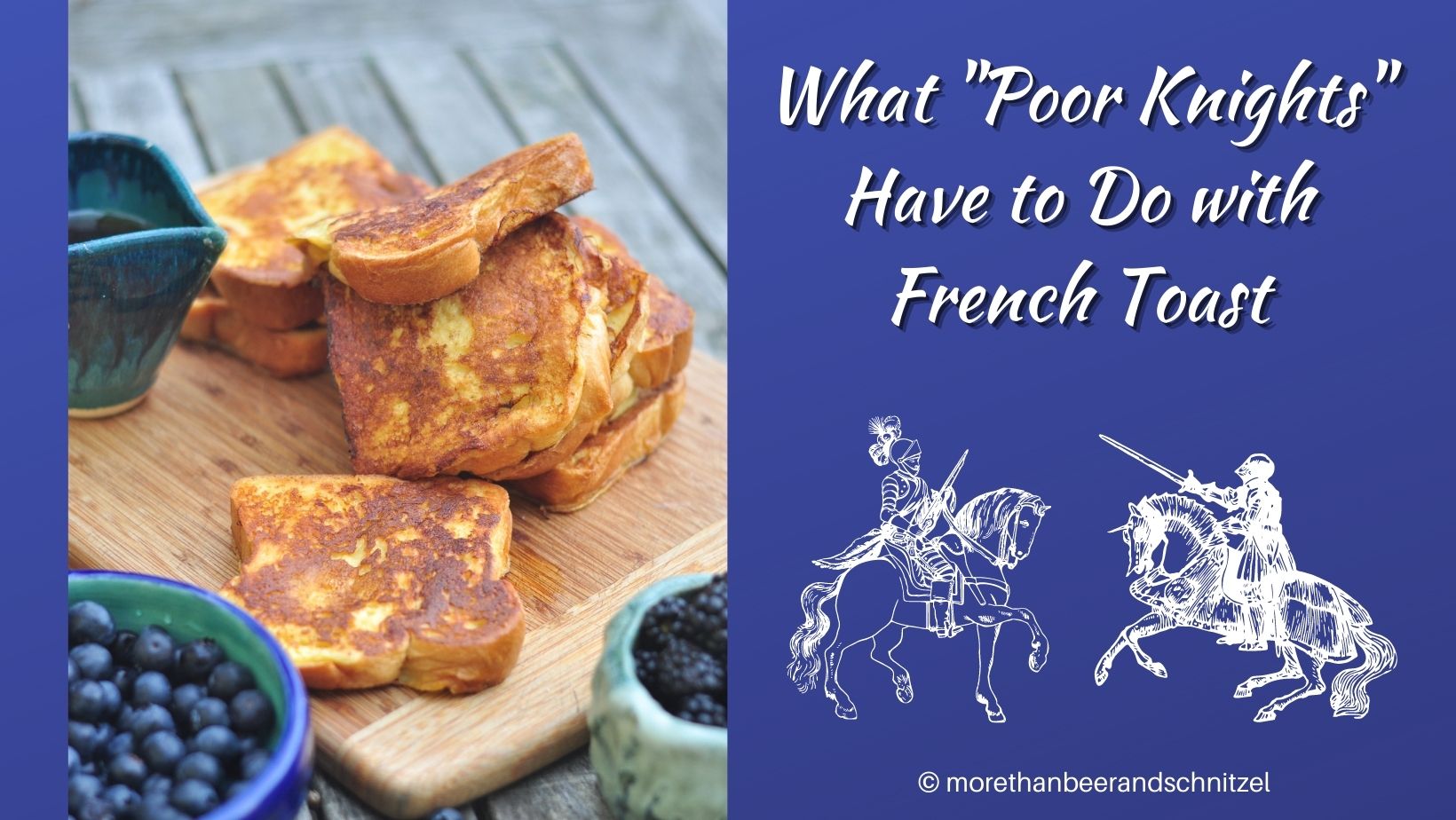So, what do “poor knights” have to do with French toast? The answer is actually quite simple. French toast is called Armer Ritter or Arme Ritter (in the plural) in German which means ‘poor knight(s)’. Though there are plenty of other names for it, in German and in English, and presumably in other languages, too.
The slices of bread soaked in a beaten egg and milk mixture, pan-fried, and often served with powdered sugar, syrup, and/or fruit, are not unique to Germany but rather seem to be a universal food, eaten everywhere where there’s bread, milk, and eggs.

Historical background
Actually, the oldest recipe found dates back to the 1st century CE. It was written in Latin in the De re coquinaria and refers to pieces of bread, with the crust cut off, dipped in milk, fried in oil, and covered in honey.
You’ll find similar recipes in early German cookbooks, e.g. in the Bůch von gůter spîse (Das Buch von guter Speise, the book of good food) from the 14th century. Though the name Arme Ritter comes later. At first, the French toast is called Gueldene Schnitten or Guldenschnitten (golden slices).
While it seems obvious why the toast would be called “golden slices” because of their color, it is not clear how they got the name Arme Ritter. The word is or was also used in England and some Nordic countries. It stands to reason that the dish earned its name because by the end of the Middle Ages the knights became poor(er), so poor in fact that they couldn’t afford to throw stale bread out. While peasants had always had to use every scrap of food, now knights had to resort too. Though there is no actual proof that knights did eat Arme Ritter.

Different names - same deliciousness
The name “French Toast” is very common in the US, in Britain you might also hear the name “eggy bread”. (I learned that one when watching Richard Hammond’s Crash Course, who would have thought?) In France, it’s not called “French toast” but “pain perdu” meaning ‘lost bread’. It refers to the stale bread that you wouldn’t eat anymore but that gets a second chance when it’s dipped in eggs and fried.
In Germany, Arme Ritter seems to be the most common word though the word “French Toast” is making its way into the German language. But there are other German expressions; some describe the exact same food, some are used for slightly different dishes. Let’s take a look!
Weckschnitten and Fotzelschnitten are the same as French toast. The latter expression is used in Switzerland, the Alsace, and South Baden. It is often sold as a sweet snack at fairs and, like the photo shows, on Christmas markets.
Schnitte in general means a slice, and comes from the verb schneiden (to cut). You can use Schnitte for bread but also for a rectangular piece of cake.
When you say Wecken in South West Germany or Switzerland, you are talking about a bread roll (Brötchen is the most generic term), but in the South East and Austria a Wecken is a loaf of bread.
Photo:Von Brainswiffer – Weihnachtsmarkt Murten, CC BY-SA 4.0, https://de.wikipedia.org/w/index.php?curid=8013743

Variations
Blinde Fische (blind fish) is another word for French toast and possibly originated in Westphalia. However, it differs a little. Generally, Blinde Fische are made with Zwieback but really you can also use old rolls or other bread.
In some recipes, the Zwieback is soaked in a egg milk mixture and then fried. But in other recipes the Zwieback is dipped in milk only. A beaten egg is poured into the pan, the milky Zwieback goes on top and the rest of the egg mix is poured over the Zwieback.
Some people like it sweet and add sugar to the egg milk mixture, others prefer it savory with ham or ketchup.
Semmelschmarrn, sometimes also called Falscher Kaiserschmarrn, has the same ingredients as French toast. The difference is that you cut stale bread into smaller pieces or thin slices and let them soak a little longer in your egg milk mixture. You’ll then fry them in a pan, and eat your mini French toast pieces with cinnamon sugar, apple sauce, or fruit compote.
The name Rostige Ritter (rusty knights) comes from the rusty color of the cinnamon sugar. For this variation you use old bread rolls. You’ll cut them in half and grate one half to make your own Brösel (bread crumbs). The bread roll halves are soaked in milk and then rolled in the bread crumbs. After that they are pan-fried and then sprinkled with cinnamon sugar.
You can also add vanilla sauce or fruit compote.
What the Bavarians call Bavesen, the Austrians call Pofesen. The name probably derives from the Italian “zuppa pavese” (soup from Pavia) which is fried bread, topped with an egg and broth poured over it. Though for the Pofesen only the fried bread remained. Often the Pofesen are called Powidl-Pofesen.
The difference between Pofesen and Arme Ritter is mainly the filling. Often two halves of a bread roll or brioche is used but normal bread works too. You basically make a sandwich with Pflaumenmus (plum puree) or the Austrian Powidl which is prune plum puree but has a higher concentration of fruit than Pflaumenmus.
After you’ve made your sandwich you soak it in the typical egg milk mixture (you may add some sugar and/or rum) and fry it until golden brown. You can sprinkle it with powdered sugar or cinnamon sugar.
Sources and Resources
- Wiki -Arme Ritter
- Pinterest Board (contains links to recipes)
- Rezept Blinde Fische
- WikiSource – Das Buch von gute Speise






